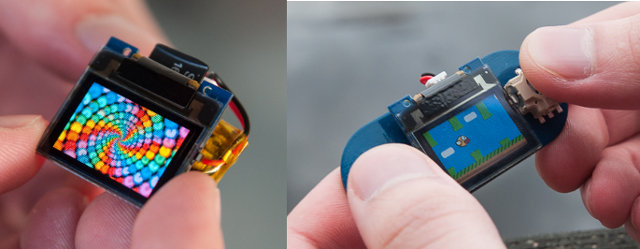Back in 2012, Tiny Circuits launched a Kickstarter campaign for TinyDuino, an Arduino compatible board that’s… tiny, based on Atmel Atmega328P, and supports tiny stackable shields in a similar fashion to Microduino (launched in 2013). The campaign was successful, and the company is now back on Kickstarter with TinyScreen, an OLED display that can be stacked on top of TinyDuino to create a smartwatch, a minuscule gamepad, smart glasses, and more.

TinyScreen technical specifications:
- 96×64 OLED display, 16-bit color depth
- 0.96″ (24.4mm) viewable area
- Software controllable backlight (OLED brightness)
- Power down mode
- Four push buttons along the sides (connected to IO pins)
- SPI interface for display
- Power Supply – 3.0V to 5.5V operation (higher voltages supported with TinyShield power regulator)
- Power Consumption – 20 – 45mA max supply current (depending on brightness)
- Dimensions – 25.8mm x 25.0mm
Programming of TinyDuino can be done through a web interface for Arduino called Codebender, that seems to provide functionality very similar to the Arduino IDE, except it’s done from your web browser. TinyDuino also supports the standard Arduino IDE, but Codebender will transparently keep TinyScreen libraries, examples, and standalone apps up-to-date. TinyDuino and TinyShields are schematics and PCB layout files (Eagle) are available on github, an the company intends to release hardware design files for TinyScreen as well. Various tutorials for TinyDuino and TinyShields can be found in tiny circuits website, and I assume TinyScreen will soon be added in this section too. Support is provided on their forums.

Unless you already own recent TinyDuino boards and shields (boards have been updated since 2012), TinyScreen would be pretty useless, so albeit the OLED display is offered as a single perk for $25, most people will be interested in the kits:
- Basic Kit ($55) – TinyScreen, TinyDuino “processor”, USB shield and Li-Po Battery.
- Video Player Kit ($65) – Basic kit + micro SD card shield.
- Video Game Kit ($75) – Basic kit + Joystick shield.
- Smart Watch Kit ($90) – Basic kit + Bluetooth LE shield.
- Deluxe Kit ($120) – Basic kit + microSD, BLE, and Joystick shield.
- Robot Control Kit ($165) – Based on Video Game kit + one extra TinyDuino board, 2x 433Mhz radio shields, and a motor x4 shield.
- Sensor Kit ($200) – Based on Smart Watch kit + Wi-Fi, Accelerometer, 9-axis DOF, ambient light, and compass shields.
There are also two perks that offer discount when you buy multiple basic kits, or a combination of kits.
The video below provides an overview of TinyScreen and some of its kits, and shows Tiny Circuits factory based in the US.
The project has already reached its funding target ($15,000) having raised over $56,000 with 18 days to go. Shipping for all perks is free to the US, and $5 to the rest of the world, with delivery scheduled for January to February 2015.

Jean-Luc started CNX Software in 2010 as a part-time endeavor, before quitting his job as a software engineering manager, and starting to write daily news, and reviews full time later in 2011.
Support CNX Software! Donate via cryptocurrencies, become a Patron on Patreon, or purchase goods on Amazon or Aliexpress




